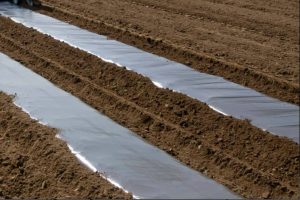A variation on the straw mulch potato growing method is to grow potatoes under black plastic sheets. There are both advantages and disadvantages to using plastic sheeting as a mulch which we cover below. Growing through plastic film is a method often used by commercial growers for a variety of crops although not for potatoes in Britain
Problems with Growing Potatoes under Black Plastic Sheeting
Slugs tend to like being under the plastic sheet and can badly damage the crop. Take precautions such as applying nematodes or scattering slug pellets along the row prior to sheeting up.
The sheeting tends to be thin and flimsy which can make it difficult to lay if there is any wind. Even when properly laid, it can be ripped to shreds by a strong wind.
Because you need to leave a space between the rows for water to get into the soil, it uses more space for the crop than other methods. An alternative is to use a more expensive permeable sheeting that will allow water through to the crop.
The sheeting is rarely re-usable so it’s an expense.
One thing to consider is how you feel about covering your beds with black plastic. I personally think it looks awful and it can hardly be said to be environmentally sound or green as plastics are produced from oil and are not usually biodegradable.
Advantages to Growing Potatoes Under Black Plastic
Once the season warms and we start getting some sunshine, the black plastic sheeting will absorb the sunlight and warm up the ground. Even a couple of degrees can make a big difference to the growth rates of the potatoes
Harvesting is very easy, just lift the sheeting and pick up the tubers.
How to Grow Potatoes Under Black Plastic Sheeting
Prepare the soil by rotavating the surface or forking and apply a layer of compost or add fertiliser. Because feeding under sheeting is not practical, you’ll need to apply a fair amount of fertiliser for the crop.
Draw narrow trenches to each side of the planting row. Allow at least 30cm (1 foot) between strips of sheet so the run-off water can get into the soil. Alternatively use a porous weed matting.
Lay rows of plastic sheet down and tuck the edges into a trench to hold in position but allow a little slack or the swelling tubers might force the plastic to tear.
Then make a small cross cut in the plastic and plant your seed potatoes shallowly through the cut, following the standard planting spaces (see insert).
Harvesting Potatoes Grown Under Black Plastic Sheeting
To harvest, just cut the haulm off and peel back the sheet to reveal the crop. The black plastic will absorb sunlight so warming the soil and help keep moisture in. It’s important to have a space between the rows so the rain can soak into the ground. As with mulch growing, slugs can be a problem but if you can control them you will have a clean, easy to harvest crop.
Potato Growing Articles
- Growing Potatoes Overview – How to Grow Potatoes Guide
- How Many Seed Potatoes are Needed
- Potato Flowers, Fruits, Seeds & Breeding
- Growing Potatoes – Standard Traditional Method
- Growing Potatoes Under Straw Mulch
- Growing Potatoes Under Black Plastic (Polythene) Sheet
- Potato Growing in Raised Beds & Ridge Planting Potatoes
- Growing Potatoes in a Barrel – Patio Growing Potatoes
- Growing Potatoes in Bags | Greenhouse Potatoes
- Second Crop Autumn Planted Christmas New Potatoes
- Can you chit supermarket potatoes?
- Potato Varieties for Flavour -Boiled Baked Roasted Mashed
- Potato Fertiliser Program Program & (NPK) Requirements
- Potato Blight Cause, Identification. Prevention, Treatment Potato Blight
- Wireworm in Potatoes Cause Identification Prevention Control Potato Wireworm
- Eelworm Potato Cyst Nematode – Control Potato Eelworm
- Dry Rot in Potatoes Cause Identification Prevention Control of Potato Dry Rot
- Potato Scab – Common Scab in Potatoes
- Potato Scab – Powdery Scab in Potatoes
- Hollow Heart, Splitting & Spraing Potatoes
- White Spots on Potatoes Lenticels & Potato Stem Rot
See Also:
- Growing Potatoes for Show, Introduction & Best Varieties
- Growing Potatoes for Show, Cultivation of Show Potatoes
- Growing Potatoes for Show Harvest & Showing Potatoes




